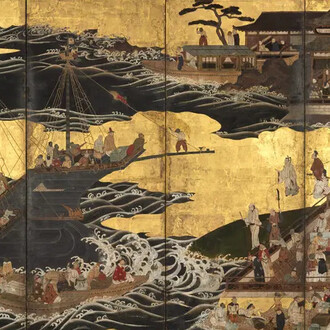Pablo Picasso’s prolonged engagement with paper is the subject of the groundbreaking exhibition Picasso and paper, organized by the Cleveland Museum of Art and the Royal Academy of Arts, London, in partnership with the Musée national Picasso-Paris.
Showcasing nearly 300 works spanning the artist’s career, the exhibition highlights Picasso’s relentless exploration of paper. His appreciation of and experimentation with the material is revealed in the works ranging from collages of cut-and-pasted papers to sculptures from pieces of torn and burnt paper, manipulated photographs, drawings in virtually all available media, and prints in an array of techniques. The exhibition’s highlights include Femmes à leur toilette (1937–38), an extraordinarily large collage (9 13/16 x 14 1/2 feet) of cut-and-pasted papers, which will be exhibited for the first time in the United States; outstanding Cubist papiers collés; artist’s sketchbooks, including studies for his best known paintings, including Les Demoiselles d’Avignon; constructed paper guitars from the Cubist and Surrealist periods; and an array of works related to major paintings and sculptural projects.
The exhibition presents these works on paper chronologically alongside a limited number of closely related paintings and sculptures. For example, the Cleveland Museum of Art’s La vie (1903), from Picasso’s Blue Period, will be featured with preparatory drawings and other works on paper exploring corresponding themes. In the Cubist section, Picasso’s bronze Head of a woman (Fernande) (1909) (Musée Picasso, Paris) will be surrounded by a large group of associated drawings. Seen together, these groupings highlight the connections that Picasso saw between media and the integral role that paper played throughout his artistic practice.
Picasso and paper is accompanied by a fully illustrated catalogue published by the Royal Academy of Arts. It features essays by distinguished Picasso scholars and leading authorities in various aspects of technical art history, including William H. Robinson, formerly of the Cleveland Museum of Art; Ann Dumas of the Royal Academy of Arts; Emilia Philippot of the Musée Picasso, Paris; and Claustre Rafart Planas of the Museu Picasso, Barcelona. Specific aspects of Picasso’s engagement with paper are addressed by Christopher Lloyd, an expert on Picasso’s drawings; Stephen Coppel, curator of prints and drawings at the British Museum; Violette Andres, photography curator at the Musée Picasso, Paris; Johan Popelard of the University of Paris; and Emmanuelle Hincelin, a paper conservator with scientific expertise in the types of paper Picasso used at key moments in his career.
















